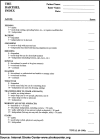Prevalence of difficult venous access and associated risk factors in highly complex hospitalised patients
- PMID: 28165645
- PMCID: PMC6084302
- DOI: 10.1111/jocn.13750
Prevalence of difficult venous access and associated risk factors in highly complex hospitalised patients
Abstract
Aims and objectives: To estimate the prevalence of difficult venous access in complex patients with multimorbidity and to identify associated risk factors.
Background: In highly complex patients, factors like ageing, the need for frequent use of irritant medication and multiple venous catheterisations to complete treatment could contribute to exhaustion of venous access.
Design: A cross-sectional study was conducted.
Methods: 'Highly complex' patients (n = 135) were recruited from March 2013-November 2013. The main study variable was the prevalence of difficult venous access, assessed using one of the following criteria: (1) a history of difficulties obtaining venous access based on more than two attempts to insert an intravenous line and (2) no visible or palpable veins. Other factors potentially associated with the risk of difficult access were also measured (age, gender and chronic illnesses). Univariate analysis was performed for each potential risk factor. Factors with p < 0·2 were then included in multivariable logistic regression analysis. Odds ratios were also calculated.
Results: The prevalence of difficult venous access was 59·3%. The univariate logistic regression analysis indicated that gender, a history of vascular access complications and osteoarticular disease were significantly associated with difficult venous access. The multivariable logistic regression showed that only gender was an independent risk factor and the odds ratios was 2·85.
Conclusions: The prevalence of difficult venous access is high in this population. Gender (female) is the only independent risk factor associated with this. Previous history of several attempts at catheter insertion is an important criterion in the assessment of difficult venous access.
Relevance to clinical practice: The prevalence of difficult venous access in complex patients is 59·3%. Significant risk factors include being female and a history of complications related to vascular access.
Keywords: comorbidity; fluid therapy; inpatients; peripheral catheterisation; vascular access devices.
© 2017 John Wiley & Sons Ltd.
Figures
Similar articles
-
Factors affecting difficult peripheral intravenous cannulation in adults: a prospective observational study.J Clin Nurs. 2017 Apr;26(7-8):1074-1084. doi: 10.1111/jocn.13444. Epub 2017 Feb 7. J Clin Nurs. 2017. PMID: 27324945
-
Experience in the use of midclavicular catheters: An inception cohort study.J Clin Nurs. 2022 Aug;31(15-16):2296-2308. doi: 10.1111/jocn.16047. Epub 2021 Sep 22. J Clin Nurs. 2022. PMID: 34553435
-
Vascular access care in patients with multimorbidity.Br J Nurs. 2021 Apr 22;30(8):S26-S35. doi: 10.12968/bjon.2021.30.8.S26. Br J Nurs. 2021. PMID: 33876690
-
Infection of totally implantable venous access devices: A review of the literature.J Vasc Access. 2018 May;19(3):230-242. doi: 10.1177/1129729818758999. Epub 2018 Mar 7. J Vasc Access. 2018. PMID: 29512430 Review.
-
Defining risk factors associated with difficult peripheral venous Cannulation: A systematic review and meta-analysis.Heart Lung. 2020 May-Jun;49(3):273-286. doi: 10.1016/j.hrtlng.2020.01.009. Epub 2020 Feb 11. Heart Lung. 2020. PMID: 32057426
Cited by
-
Design and Evaluation of a Handheld Robotic Device for Peripheral Catheterization.J Med Device. 2022 Jun 1;16(2):021015. doi: 10.1115/1.4053688. Epub 2022 Mar 2. J Med Device. 2022. PMID: 35284032 Free PMC article.
-
Risk Factors for Difficult Peripheral Intravenous Cannulation. The PIVV2 Multicentre Case-Control Study.J Clin Med. 2020 Mar 15;9(3):799. doi: 10.3390/jcm9030799. J Clin Med. 2020. PMID: 32183475 Free PMC article.
-
First-in-human evaluation of a hand-held automated venipuncture device for rapid venous blood draws.Technology (Singap World Sci). 2019 Sep-Dec;7(3-4):98-107. doi: 10.1142/S2339547819500067. Epub 2020 Jan 22. Technology (Singap World Sci). 2019. PMID: 32292800 Free PMC article.
-
A clinical pathway for the management of difficult venous access.BMC Nurs. 2017 Nov 17;16:64. doi: 10.1186/s12912-017-0261-z. eCollection 2017. BMC Nurs. 2017. PMID: 29176933 Free PMC article.
-
Factors associated with delayed order-to-administration time in the emergency department: a retrospective analysis.BMC Emerg Med. 2025 Apr 28;25(1):74. doi: 10.1186/s12873-025-01229-5. BMC Emerg Med. 2025. PMID: 40295912 Free PMC article.
References
-
- Bensghir M, Chkoura K, Mounir K, Drissi M, Elwali A, Ahtil R, Meziane M, Alaoui H, Elmoqadem A, Lahlou J, Hatim A, Azendour H & Drissi Kamili N (2012) Peripheral intravenous access in the operating room: characteristics and predictors of difficulty. French Annals of Anesthesia and Reanimation 31, 600–604. - PubMed
-
- Brannam L, Blaivas M, Lyon M & Flake M (2004) Emergency nurses’ utilization of ultrasound guidance for placement of peripheral intravenous lines in difficult‐access patients. Academic Emergency Medicine 11, 1361–1363. - PubMed
-
- Burns T & Lamberth B (2010) Facility wide benefits of radiology vascular access teams. Radiology Management 32, 28–32; quiz 33‐4. - PubMed
-
- Caballero C (2006) Propuesta de formación de equipo de terapia intravenosa (Proposal to establish an Intravenous Therapy Team). Revista Rol de Enfermería (Nursing Rol) 29, 34–38. - PubMed
MeSH terms
LinkOut - more resources
Full Text Sources
Other Literature Sources



